
BMW 3 Series Touring
Generations Timeline, Specs and Pictures

After more than three decades and 1.7 millions cars on the road, BMW brought out the 2019 3 series Touring, the sixth generation of the model. The new station wagon is longer by 76 mm (3 in), reaching a total of 4709 mm (15.4 ft) compared to its predecessor. The wheelbase was increased by 41 mm (1.61 in), thus giving more room for the occupants. The trunk has been increased to a total volume of 500 liters (17.65 cu-ft), which can triple by folding down the rear seats to a total of 1510 liters (53.3 cu-ft).
Inside, the premium feeling is obvious due to the high quality of the materials used, especially if the vehicle is fitted with upper trim levels. A panoramic glass roof is offered as an option to increase the light and atmosphere inside. For the infotainment system, BMW added its newest generation of iDrive.
For the headlights, BMW offers LED fitted as standard with another upgraded LED system available for extra money and, for those who really wants to transform night into a day, the Laserlight, which can light-up the road ahead up to 530 m (1739 ft).
For the engine compartment, BMW installed a base unit with four-cylinders, a 150 hp turbodiesel. The top-version is the M340i with a six-cylinder 3.0-liter unit, which offers 374 hp. An all-wheel-drive system (called xDrive) is available only for engines with power from 190 hp up.

In 2016, BMW introduced the facelift for the sixth generation of the 3-Series for all the range, including the station-wagon.
Along with some subtle exterior changes, there were some technological upgrades.
Apart from the first generation of the 3-series, all the others were offered with a station-wagon bodywork as well. That would make the F31 the fifth-generation of the Touring version for the 3-Series. The generation was introduced at the 21st Auto Mobil International held at Leipzig in 2012 and it was updated four years later.
For the exterior, the LCI (Life-Cycle Impulse) introduced a new apron with revised air-intakes. The sensor for the optional Active Cruise Control (ACC) was integrated into the central air-intake. For the headlights, a new full-LED option was added to the list. In the rear, a new apron and new standard LED lights were installed.
On the inside, there was a newly crafted center console with a sliding cover for the cup-holders, that was better used for mobile phones. The instrument cluster featured the same four-dials gauges, accompanied on the center stack by a widescreen for the infotainment unit. In the rear, the split-folding seats allowed up to 1500 liters (53 cu-ft) of trunk space if the usual 496 liters (17.5 cu-ft) volume was not enough.
For the engines, 2016 3 Series Touring was available with a choice of gasoline and turbocharged diesel engines, mated to either a 6-speed manual or an 8-speed automatic. The standard transmission was rear-wheel drive while specific versions were fitted with all-wheel-drive.

The new edition of the BMW 3 Series Touring makes its mark in the premium sports estate segment with its hallmark BMW dynamic prowess, enhanced practicality and versatility, and a range of standard equipment features assembled to meet the challenges of everyday life.
The new car’s larger interior is extremely versatile and designed to adapt to everything its customers’ modern, active lifestyles can throw at it. In this role, the new BMW 3 Series Touring convinces equally as both a sporty, elegant and dynamic way to eat up the miles and a comfortable and spacious vehicle for sports and leisure pursuits.
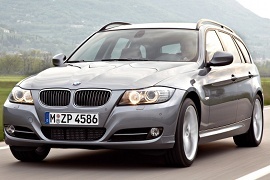
BMW introduced a mid-life cycle refresh for the whole 3-Series range in 2008 and improved the station wagon version named Sports Wagon in North America or Touring in Europe.
The German carmaker had to improve its cars to fit into the Euro 5a emission standards. Since it had to refresh the engines, it added other modifications to the car’s exterior and interior. Worth mentioning that the 3-Series was the best-selling BMW model globally.
At the front, the main difference was on the company’s “kidney” grille design, which featured rounded interior edges instead of the clear-cut style used before. BMW also included the grille’s chromed top rim in the front fascia, not on the hood as it was on the pre-facelifted version. The lower bumper area received a smiling cut instead of the straight one. Further modifications followed in the rear, where the new LED taillights featured smaller reversing lights.
Inside, the most visible change was for the automatic transmission selector. On the 2008 model, BMW adopted the joy-stick system used on the bigger brother 5-Series instead of the classic, linear style with a side gate for the manual mode. The 40/20/40 split-folding bench in the rear allowed the trunk to increase its size from 460 liters (16.2 cu-ft) to 1,385 liters (48.9 cu-ft)
Under the hood, the German carmaker offered a vast engine choice and started it with a 2.0-liter naturally aspirated gasoline unit that provided 136 hp, seven more than its predecessor. For turbo-diesel versions, BMW introduced a fuel-efficient 115 hp unit paired with a 6-speed manual. The carmaker renamed the all-wheel-drive versions as xDrive instead of xD or xI as before.
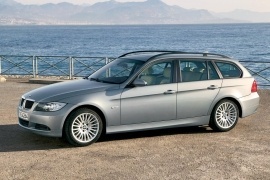
After the great success the Bavarian manufacturer had with the 4th generation of the 3-series, namely the E46, BMW decided it was time for a brand new model that would still turn heads.
The new 3-series, also named E90 (sedan), E91 (touring), E92 (coupe) and E93 (cabriolet) had a completely redesigned body, using lines inspired from the 5-series.
Compared to the E46, the new model came with a larger wheelbase, thus enhancing passenger comfort. BMW claimed that the boot size was also better, however, the spare tire disappeared starting with 2005. The new 3-series ran on run-flat tires and such the storage space was increased.
The new E90’s body was by 25% stiffer than the older’s model and, of course, safety was enhanced. Other safety features included ABS, dynamic stability control, traction control and others.
Specific to the brand, the timeless design of the E90 attracted buyers for many years, while still keeping its value.
Coming with a variety of engines, the new model could satisfy the needs of every driver. While most of the powerplants were punchy, the fuel consumption was kept as low as possible.
And while it’s not always about how many ponies are to be found under the hood, the E90 offered a great driving experience with its precise steering and great handling.
As we like to say, the BMWs were and still are designed for the most pretentious drivers.
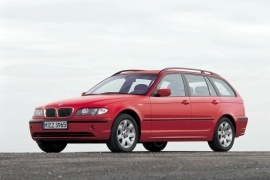
BMW introduced a facelifted version of its 3-Series in 2001 and improved it to match its main competitor, the C-Class from Mercedes.
Ever since the 3-Series E30, BMW offered its compact segment contender in a station wagon shape, fit for those who needed a car for the family but didn’t want to give up to the sporty rear-wheel-drive feeling. When the E46 (fourth generation) came on the market in 1998, the Touring (station wagon) was already planned. By 2001, the car’s image was already old, and the carmaker already had the refreshed version cooked and ready to go.
From the outside, there were minor changes to the bodywork. The distinctive new look of the headlights, with a double curved line on the bottom, matched the new bumper. At the back, there were no changes to the taillights or the bumper.
Inside, the carmaker introduced new options for steering wheels and installed paddle shifters for the automated (SMG) transmission. The center console received more buttons for additional safety equipment (Dynamic Stability Control). A significant improvement was for the infotainment unit, which received a color screen for the navigation system.
The most important change was for the drivetrain, where a new engine lineup was introduced. The base model was a 1.8-liter unit, named 316i, which offered 115 hp. The most popular version was the 318i, which offered a 2.0-liter unit rated at 143 hp. It was the first 2.0-liter with four cylinders installed on a BMW since the first generation. Top of the range version was the 231 hp 3.0-liter unit, which could have been mated to a 6-speed manual with a rear or all-wheel-drive system. All versions were available with an automatic, 5-speed transmission.
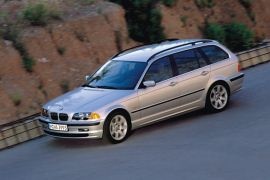
In the late ’90s, the station wagon market in Europe was high.
After the big success of the BMW 3 Series Touring (station wagon) for the previous E36 generation, the BMW board decided to make a sequel. So, the 3 series touring appeared. But in the U.S., the demand for premium compact station wagons was low. So it built it with only two engine variants, both of 2.5-liter inline 6 and one of them was approved as a SULEV vehicle (super ultra low emission vehicle). In Europe, the engine offer was much wider, including turbodiesel units and other displacements. It was available even with a 1.8-liter version, which was, actually, kind of weak for the over 1.5-ton vehicle.
When the E46 appeared, it had the longest wheelbase in the compact market. Its 2.7 m (107”) long-wheelbase should have been translated into more room for the rear passengers. But, since the engine was mounted longitudinally, they didn’t have enough. It was just ok.
But the 3 series E46 touring model was important for another thing. Due to a big demand for the station wagon with an all-wheel-drive system (325 iX and 330 iX), BMW understood that it is time for a small SUV. And that’s how the X3 was born.
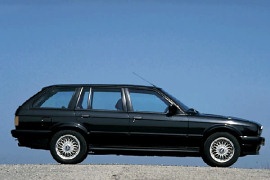
The second generation of the 3-Series was launched in 1982 but it wasn’t until the car’s mid-life cycle refresh until the station-wagon was launched.
It was the first 3-Series that had the Touring name.
The station-wagon mania started in the mid-’80s and the premium manufacturers didn’t offer that kind of bodywork on the compact-sized vehicles. While Mercedes-Benz and Audi already had station-wagons in its lineup, BMW didn’t have anything to offer in that segment.
The 3-Series touring was the same car from the grille to the B-pillars, but after that, it was changed with a longer roof, different rear quarter panels, and the addition of the D-pillars. The C-pillars were slimmer than those from the sedan. The tailgate featured an innovative system with the window opening independently from the rest of the tailgate, or together with it.
Inside, there was no difference in headroom between the sedan and the touring since the sedan already featured a long roof. The rear seats featured a folding seatback to extend the trunk space. It also kept the go-through folding panel to allow ski-transport.
The 3-Series Touring was offered with 4 and 6 cylinders engines, both gasoline and diesel. The introduction of the all-wheel-drive system for the 325 iX version was also introduced for the station-wagon.























































